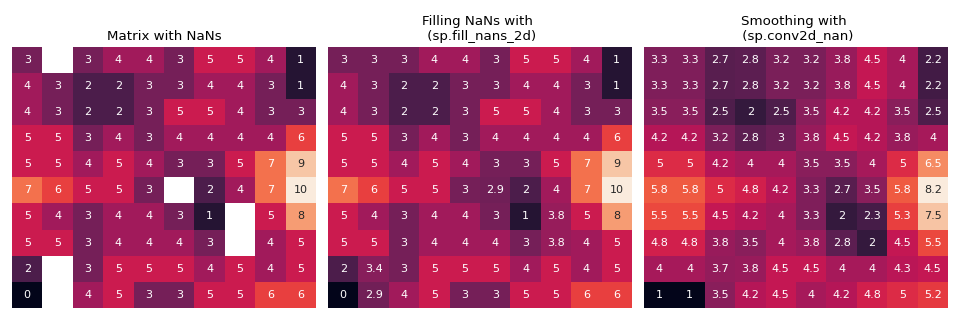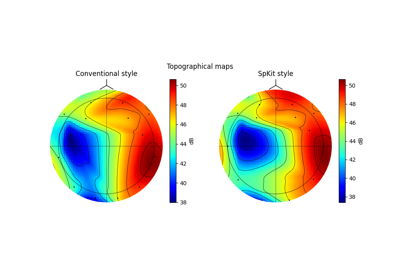spkit.fill_nans_2d¶
- spkit.fill_nans_2d(X, pkind='linear', filter_size=3, method='conv', clip_range=[None, None], restore_original_values=True)¶
Fill nan values with interpolation/exterpolation for 2D
Fill nan values with interpolation/exterpolation for 2D
- This function applies
Inter/exter-polation to estimate missing values
Smooting with filter_size, if
filter_size>0Restore original values, if
restore_original_valuesTrueFinally, clipping values if
clip_rangeis provided.
This function uses ‘fill_nans_1d’ for each column and each row. This results two inter/exter-polated values for each missing value
To fill the missing value, function takes average of both, which reduces the variability along both axis.
Further to remove any artifacts created by new values, smoothing is applied. However, original values are restored.
Finally, if clip_range is passed, values in new matrix are clipped using it.
- Parameters:
- X: 2d-array
array with missing values, denoted by np.nan
- pkindkind of interpolation, default=’linear
one of {‘linear’, ‘nearest’, ‘nearest-up’, ‘zero’, ‘slinear’, ‘quadratic’, ‘cubic’, ‘previous’, or ‘next’. ‘zero’}
- filter_size: int
A 2d-filter size to apply smoothing, a kernel of filter_size x filter_size
is created and convoled with matrix
- method: str, {‘conv’, ‘conv_nan’}, default = ‘conv’
convolution method
if method=’conv’, conventional convolution is applied, in this case,
‘filter_size’ can be of any length>1
- if method=’conv_nan’, a convolution operation, that can handle NaN values is used.
For this, filter_size should be an odd number, if even number is passed, 1 is added to make it odd
- restore_original_values: bool, default =True
if True, original values are restored
- clip_range: list of two [l0,l1]
After (1) inter-exter-polation, (2) applied smotthing,(3) restoring original values
matrix values are clipped with clip_range.
This is only applied if at least of the clip_range values is not None.
- Returns:
- XINew Matrix,
where NaN are filled, but original values are left un-changed, except clipping
- XkNew Matrix,
same as XI, except, original values are not restored, or clipped.
See also
Examples
>>> import numpy as np >>> import spkit as sp >>> np.random.seed(seed=2) >>> X = np.random.randint(0,10,[5,5]) >>> r = 1*(np.abs(np.random.randn(5,5))<1.4).astype(float) >>> r[r==0]=np.nan >>> X_nan = X*r >>> print(X_nan)
array([[ 8., 8., 6., 2., nan], [ 7., 2., nan, 5., 4.], [nan, 5., 7., 3., 6.], [ 4., 3., 7., 6., 1.], [nan, 5., 8., 4., nan]])
>>> X_filled, X_smooth = sp.fill_nans_2d(X_nan) >>> print(X_filled.round(1))
array([[8. , 8. , 6. , 2. , 1.9], [7. , 2. , 4.8, 5. , 4. ], [4.5, 5. , 7. , 3. , 6. ], [4. , 3. , 7. , 6. , 1. ], [3.3, 5. , 8. , 4. , 0.9]])
>>> ##################################### >>> #sp.fill_nans_2d >>> import numpy as np >>> import matplotlib.pyplot as plt >>> import seaborn as sns >>> import scipy >>> import spkit as sp >>> seed = 2 >>> I = (sp.create_signal_2d(n=10,seed=seed,sg_winlen=3)*10).round(0) >>> np.random.seed(seed) >>> r = np.random.rand(*I.shape) >>> I[r<0.05] = np.nan >>> np.random.seed(None) >>> kernel = np.ones([2,2])/4 >>> I_spkit = sp.conv2d_nan(I.copy(), kernel, boundary='reflect',fillvalue=0) >>> I_fill, I_sm = sp.fill_nans_2d(I.copy()) >>> plt.figure(figsize=(12,4)) >>> plt.subplot(131) >>> sns.heatmap(I, annot=True,cbar=False,xticklabels='', yticklabels='') >>> plt.title('Matrix with NaNs') >>> plt.subplot(132) >>> sns.heatmap(I_fill, annot=True,cbar=False,xticklabels='', yticklabels='') >>> plt.title('Filling NaNs with \n (sp.fill_nans_2d)') >>> plt.subplot(133) >>> sns.heatmap(I_spkit, annot=True,cbar=False,xticklabels='', yticklabels='') >>> plt.title('Smoothing with \n (sp.conv2d_nan)') >>> plt.tight_layout() >>> plt.show()







